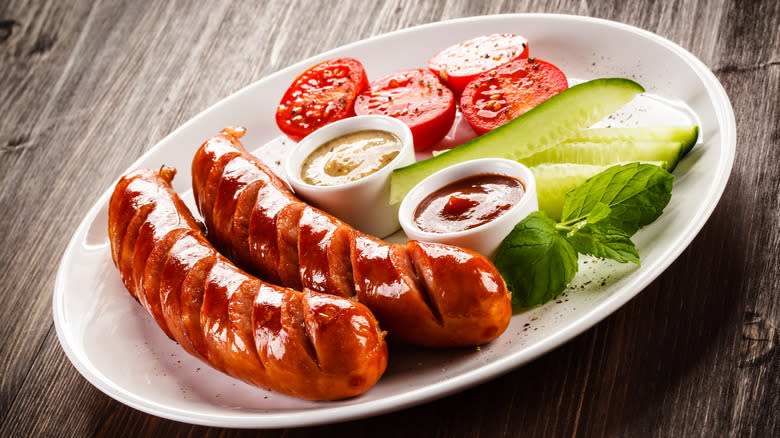Switch Up How You Eat Sausages With A Quick Hasselback Technique

While it's perfectly fine to dive right in and take a big ol' bite out of your next brat or kielbasa, using the hasselback technique is a particularly fast and tasty way to switch up how you go about enjoying your favorite sausages. In fact, it may just be your key to sausage heaven -- especially if you're a fan of those deliciously browned bits that make sausages such a triumph to behold in the first place.
Hasselbacking refers to the process of making successive notches that slice almost all the way through the food, but still leave the base of the item intact. In addition to providing visual appeal with its segmented shape, the cuts create more opportunities for the sausage to become crisped and browned; their grooves make great hiding spots for sauces, glazes, and seasonings. Note -- when applied to sausage, the hasselback technique should only be attempted with fully-cooked varieties. It's best to avoid piercing the skin of a raw sausage prior to cooking, as it can dry it out.
Read more: 11 Of The Best Cooking Tips From Bobby Flay
Hasselbacking Without The Hassle

Hasselback potatoes are perhaps the most traditional use of the technique, and the crispy edges created from the slicing produce an almost french fry-esque texture to the bite. Though the method works perfectly for it, sausage in hasselback form isn't as common, though Food Network star and celebrity chef Ina Garten has put the technique to good use in her cooking and raved about it on Instagram.
When hasselbacking with sausage, it's best to use a larger variety such as knockwurst, kielbasa or andouille. Remember — the more exposed surface area, the better. Slice across the sausage with a series of deep cuts anywhere from ¼ to 1 inch apart from each other and throw it in the oven to roast at 400 or 425 degrees Fahrenheit for at least 20 minutes, or until all of the edges brown up nicely. This will also work great on a grill, particularly a charcoal grill, as the smokiness of the sausage will be enhanced and a bit of extra charring will add lovely flavor as well. With either method, if you are applying any glazes, you can brush them on every 10 minutes until cooking is complete.
Glaze Your Way To Supreme Hasselbacked Sausage

The versatility of sausage lends itself to many applications, and, in addition to hasselbacking, there are many sausage cooking hacks to aid in preparing them. Spiraling your hot dogs is a variation on hasselbacking, but of course the hasselback method would work brilliantly with franks and wieners as well. A loaded-up, hasselbacked chili dog topped with mustard and onions is not only prettier to look at, but a lot less messy, too -- thanks to the way the crevasses catch the condiments.
Whatever sausage you choose to hasselback, you'll want to make sure you pair your glazes, sauces, and seasonings accordingly. An Italian sausage kicks up nicely with a shake of red pepper flakes and a few peppers and onions, and much like with the hot dogs, the slits on the meat offer great resting spots for all of these ingredients. German sausages are generally best served in a straightforward presentation with just a bit of mustard, but hasselbacking them will add brilliant edges full of texture that would have been absent otherwise. A honey glaze can pair brilliantly with something lighter like a chicken apple sausage or even a breakfast sausage. And the heat from the grill or oven will caramelize the sugars too, meaning even more sweet, crispy goodness to sate your palate.
Read the original article on Daily Meal.

